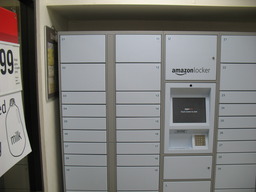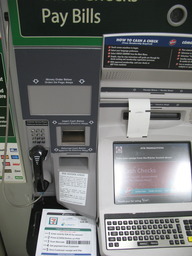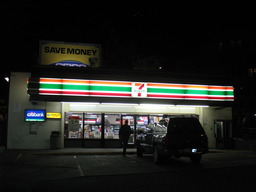Convenience Store
 Seattle, USA
Seattle, USA
October 18, 2011
America seems to be resembling Asia more and more. Latest case in point: convenience stores here have finally become convenient.
The last time I stepped into any convenience store in this country must have been back when I was a teenager. Those were days when my brothers and I might slip off after school to the 7-Eleven down the street to play Road Blasters, a video game fed by quarters. But since then, what reason would I have had to go to any convenience store? Fare such as chili-cheese dogs and Super Big Gulps lost appeal long before I left adolescence. Even as a kid I could tell that, on top of having a lousy selection, anything bought from one of those places would cost well more than it would from any supermarket.
My perception of what the local Circle K or AM/PM Mini-Mart had on offer began to change when I started spending time traveling around Asia. Convenience stores were ubiquitous throughout the centers of big Asian cities. When traveling through hot climates, I often stopped in for something large and cold to drink: initially that was a bottle of water or a carton of juice--but I soon found even familiar junk food was tinged with the exotic: the local 7-Eleven near where I grew up never sold lychee-flavored Slurpees.
 Convenience stores started looking better yet when I worked in Tokyo for a period of several months. My first stop out of the subway into work every morning was a shop at the base of my office tower to pick up a carton of orange juice or cold oolong tea to sip on while at my desk. Throughout the day, I made occasional trips back down to the ground floor to pick up a snack or another carton of something to drink. The prices were about the same as anywhere else around town.
Convenience stores started looking better yet when I worked in Tokyo for a period of several months. My first stop out of the subway into work every morning was a shop at the base of my office tower to pick up a carton of orange juice or cold oolong tea to sip on while at my desk. Throughout the day, I made occasional trips back down to the ground floor to pick up a snack or another carton of something to drink. The prices were about the same as anywhere else around town.
Even better, I found that food prepared in Japanese convenience stores was in many ways opposite that from U.S. convenience stores. Not only was the former quick and cheap but tasty and fresh, as well. My first exposure to onigiri (triangular patties of sticky rice wrapped in crispy seaweed and filled with anything from pickled plum to salmon roe) was off the shelf of an AM/PM Mini-Mart. I began picking up an onigiri or two when I didn't have time for a full, proper meal--and some times even when I did.
I had reasons other than snacks to bring me in. Convenience stores were the default place throughout Japan to pay any kind of bill. (This was an era back before the Web had become useful.) I went in once every month to pay my telephone bill. I would also go in on occasion to pick up parcels. If a delivery was attempted at a time when I wasn't at my apartment, the courier would leave a slip with instructions and directions. Rather than notifying me of another upcoming delivery attempt or sending me to some faraway shipping hub, the sheet of paper directed me to a nearby 24-hour convenience store to retrieve my parcel. I could pick up my shipment at my leisure; the delivery company could be certain it made it to the intended recipient.
But, even having been convinced of their utility many years ago, I had little reason to go to a convenience store whenever back in the U.S.. They didn't offer nearly the same range of services. That is, until I found on this current visit how America has become more like Asia:
My bank recently began allowing for free withdrawals from cash machines at 7-Eleven locations. That was enough to start bringing me in whenever I needed cash. Then, when booking a bus ticket to Vancouver on-line a few days ago I found another reason. The website flashed a message:
"Book your Greyhound ticket by phone or online and pay cash for it at a particpating 7-Eleven."
 I wondered whether that would be as easy as paying my telephone bill in Tokyo had been. Paying in-person would also offer me a marginally lower fare than paying on-line with my credit card.
I wondered whether that would be as easy as paying my telephone bill in Tokyo had been. Paying in-person would also offer me a marginally lower fare than paying on-line with my credit card.
At the shop, my bus ticket printed off easily enough onto an ordinary cash register receipt. Behind me along the back wall of the store I spied yet another element of technology that I first saw while living in Asia. A large bank of lockers was labeled, "Amazon Locker". They looked exactly like automatic lockers I often used while shopping at grocery stores throughout China--though I think they served a different function.
Before entering the shopping floor of supermarkets in most Chinese cities, customers are required to deposit their bags in such lockers. Pressing a large button pops open the nearest empty locker and prints off a receipt with unique bar code. To retrieve their bags after shopping the customer scans that printed slip, automatically opening the same door. (Maybe I'm clueless. Perhaps such storage lockers are commonplace and already exist at stores throughout the U.S. now, too. I just haven't seen them elsewhere in this country... yet.)
At a glance, I'd bet that what I saw when printing off my bus ticket was a combination of the two services I used living back in Asia. I suspect that this must be the "new" way to pick up parcels. Just key in the code left by a deliveryman at a bank of automatically opening lockers to retrieve your package. Technology that has been a normal part of daily life across Asia for years is only now being introduced in this country.
In a weblog entry seven years ago I mused about how some aspects of the infrastructure I saw in China were more developed than what I knew from the U.S.. Nowadays, some of the things I wrote about in that entry have become commonly adopted across the U.S.: specifically countdown timers at crosswalk signals. Those are installed in most cities here now--though where I first saw them was in Xinjiang, many years before I saw any here.
I expect the U.S. to continue to more and more resemble other places I've lived.
 Convenience stores started looking better yet when I worked in Tokyo for a period of several months. My first stop out of the subway into work every morning was a shop at the base of my office tower to pick up a carton of orange juice or cold oolong tea to sip on while at my desk. Throughout the day, I made occasional trips back down to the ground floor to pick up a snack or another carton of something to drink. The prices were about the same as anywhere else around town.
Convenience stores started looking better yet when I worked in Tokyo for a period of several months. My first stop out of the subway into work every morning was a shop at the base of my office tower to pick up a carton of orange juice or cold oolong tea to sip on while at my desk. Throughout the day, I made occasional trips back down to the ground floor to pick up a snack or another carton of something to drink. The prices were about the same as anywhere else around town.
 Seattle, USA
Seattle, USA
 I wondered whether that would be as easy as paying my telephone bill in Tokyo had been. Paying in-person would also offer me a marginally lower fare than paying on-line with my credit card.
I wondered whether that would be as easy as paying my telephone bill in Tokyo had been. Paying in-person would also offer me a marginally lower fare than paying on-line with my credit card.